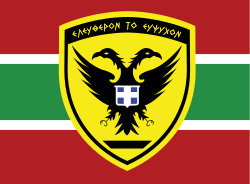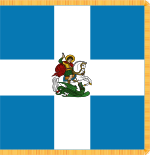Hellenic Army
| Hellenic Army | |
|---|---|
 Hellenic Army Seal |
|
| Active | 1821 (de facto) 1828 (official) |
| Country | |
| Allegiance | |
| Type | Land Forces |
| Role | National Defense |
| Size | standard numbers in peacetime: over 100,000 personnel mobilization capability in wartime: over 1,500,000 troops |
| Part of | Hellenic Armed Forces |
| Formations | Formations of the Hellenic Army |
| Patron | Saint George |
| Motto | Freedom Stems from Valor |
| Equipment | Equipment of the Hellenic Army |
| Engagements | Greek War of Independence Greco-Turkish War of 1897 First Balkan War Second Balkan War World War I Allied Expedition to the Ukraine Greco-Turkish War of 1919–1922 World War II Greek Civil War Korean War Gulf War War in Afghanistan War on Terrorism |
| Commanders | |
| Chief of Staff | Lt. General Frangoulis Frangos |
| Inspector General | Lt. General Stylianos Nasis |
| Notable commanders |
King Constantine I, Gen. Panagiotis Danglis, Fld. Marshal Alexander Papagos, Gen. Nikolaos Plastiras |
| Insignia | |
| Identification marking | ΕΣ |
| Regimental War Flag |  |
The Hellenic Army (Greek: Ελληνικός Στρατός Ξηράς, Ellinikós Stratós Xirás, literally "Hellenic Land Army"), formed in 1828, is the land force of Greece.
The motto of the Hellenic Army is Ἐλεύθερον τὸ Εὔψυχον (Eleútheron tò Eúpsychon), "Freedom Stems from Valor", from Thucydides's History of the Peloponnesian War (2.43.4). The Hellenic Army Emblem is the two-headed eagle with a Greek Cross escutcheon in the centre, representing the links between modern Greece, the Greek Orthodox Church, and the Byzantine Empire.
Contents |
Mission
The main mission of the Hellenic Army is the defence of the state’s independence and integrity, the safeguarding of national territory, as well as the decisive contribution to the achievement of the country’s policy objectives.[1]
During peacetime, the Army has the following main objectives:
- The maintenance of high operational readiness for the prevention and effective confrontation of dangers and threats, as well as the ensuring of rapid response capability.
- The contribution to international security and peace.
- The contribution to activities of social aid and the support of state services for the confrontation of emergency situations.
History
The modern Hellenic Army was formed shortly after the creation of the State in 1828. The first out of eight tactical army regiments was established in February 1828 after the respective order was given by the first head of state of the independent Greece, Ioannis Capodistrias.[2] This tactical army would replace the irregular military bands of the capetanei (καπεταναίοι - commanders) who had led the revolt against Ottoman Empire in 1821. The new formations were formed firstly in Troizina and were organized according to the ones of the French Army. First commander was appointed the French general Charles Nicolas Fabvier. In addition to the creation of tactical infantry units, Capodistrias proceeded in the establishment of various other auxiliary corps, such as the Hellenic Military Academy, the first Artillery and Cavalry battalions, the Mechanics Corps and a unit of logistical support, the Army Commissariat. The first combined arms drills were executed in October 1829 at Megara.
The Hellenic Army has taken part in the following engagements:
- Greek War of Independence (1821–1830)
- Greco-Turkish War of 1897
- First Balkan War (1912–1913)
- Second Balkan War (1913)
- Macedonian Front of World War I (1916–1918)
- Allied Expedition to the Ukraine (1919)
- Greco-Turkish War of 1919-1922
- Second World War
- Greco-Italian War (1940–1941)
- German invasion and Battle of Crete (1941)
- North African Campaign (1941–1943)
- Italian Campaign (1944)
- Greek Civil War (1946–1949)
- Korean War (1950–1953)
- War in Afghanistan (2001–present)
- War on Terrorism (2001–present)
Note: During World War II, the Army's equipment included the French Rifle Lebel M1886, the French Machinegun St. Etienne M1907, the French machinegun Hotchkiss M1914, the Belgian Rifle Mauser M1930 the Austrian Machinegun Schwarzlose M1907/12, the French machinegun Hotchkiss M1928, the Austrian Infantry Rifle Mannlicher-Schönauer M1903, and the French Machinegun Chauchat M1915.[3]
Structure
General Staff
- Hellenic National Defense General Staff
- Hellenic Army General Staff
Γενικό Επιτελείο Στρατού (ΓΕΣ)- Chief-of-Staff of the Army
Αρχηγός ΓΕΣ - Inspector General of the Army
Γενικός Επιθεωρητής Στρατού / Διοικητής ΔΙΔΟΕΕ - 1st Deputy Chief-of-Staff of the Army
A' Υπαρχηγός ΓΕΣ - 2nd Deputy Chief-of-Staff of the Army
Β' Υπαρχηγός ΓΕΣ
- Chief-of-Staff of the Army
- Hellenic Army General Staff
Combat and support arms
- Most combat arms are called "Arm" (Όπλον). This term denotes army elements that, more or less, have direct participation in combat.
- Most support branches are called "Corps" (Σώμα), with some exceptions.
Army units and formations
After a major reorganization which occurred in the last decade, which included the transformation of most Infantry formations into Mechanized Brigades and a parallel reduction of personnel, Hellenic Army's higher command is the Hellenic Army General Staff.
There are four major military commands which supervise all army units,
- The
 1st Army, based at Larissa, that includes the I and IV Army Corps, responsible for the defense of the northern and eastern borders.
1st Army, based at Larissa, that includes the I and IV Army Corps, responsible for the defense of the northern and eastern borders. - The
 II Army Corps, based at Veroia, which groups all the rapid reaction forces of the army
II Army Corps, based at Veroia, which groups all the rapid reaction forces of the army - The
 Supreme Military Command of the Interior and Islands, based at Athens with the mission to provide cover for the islands in the Aegean Sea.
Supreme Military Command of the Interior and Islands, based at Athens with the mission to provide cover for the islands in the Aegean Sea. - The
 Supreme Military Support Command undertaking various logistics and organizational tasks.
Supreme Military Support Command undertaking various logistics and organizational tasks.
Although divisions still exist, having the role of forward commands, the Army is mainly organized in brigades, that follow the typical NATO standards consisting of five battalions, three maneuver, one artillery, one support and some other company sized formations. According to the latest developments, up to 2015, all active divisions will dissolve, but all brigades will acquire one more maneuver battalion, largely eliminating the distinction between mechanized and armored formations, thus creating a new type brigade, which will be named Strike Brigade.[4]
Personnel
There are three classes of personnel in the Hellenic Army, namely professional, volunteer and conscript. Conscript enlisted men and non-commissioned officers wear special rank insignia to differentiate them from volunteers. There are currently 126,560 personnel on active duty. Mobilization strength is 600,000 more.
Most professional officers graduate from the Evelpidon Military Academy in Athens (Στρατιωτική Σχολή Ευελπίδων) and the Corps Officers Military Academy in Thessaloniki (Στρατιωτική Σχολή Αξιωματικών Σωμάτων), while the rest graduate from various Military Schools according to their specialization.
In the chain of command, graduates of the two Military Academies in Athens and Thessaloniki are considered higher in seniority compared to professional officers of the same rank who graduate from specialized Military Schools. The latter officers are followed in seniority by volunteer and finally conscript staff.
During war, the Hellenic army battalions are commanded by either a ranking officer major general or if in a combat mission by a other state which in agreement with the Greek state will be commanded by a ranking General of their own.
Equipment
The heavy equipment and weaponry of the Hellenic Army is mostly of foreign manufacture, from German, French, American, British and Russian suppliers. A notable exception is the native-built Leonidas armored fighting vehicle by the Hellenic Vehicles Manufacturer Industry (ELBO).
Equipment runs the gamut from state-of-the art to obsolescent Cold War inventories; the latter are gradually being retired.
Uniforms and Ranks
The structure of Hellenic Army ranks has its roots in British military traditions and follows NATO standard rank scale. The rank of Stratarchis (Στρατάρχης, equivalent to Field Marshal or General of the Army) though, has been historically used, but is no longer extant. It was first awarded to King Constantine I for his leadership in the Balkan Wars. The rank was subsequently assumed by his successors upon accession, until the abolition of the monarchy. The only regular officer to have been awarded the rank was General Alexander Papagos on 28 October 1949.
Gallery
 The sortie of Messolonghi, during the Greek War of Independence. Oil painting by Theodoros Vryzakis. |
 Units on the World War I Victory parade (1919). |
Greek Army IFOR deployment during the Bosnian elections. |
Greek Army Aviation AH-64A Apache attack helicopter. |
|
Greek Army Aviation CH-47SD Chinook transport helicopter. |
 The Hellenic Army Presidential Guards Unit (Evzones) parading. |
 The various uniforms of the Presidential Guard.
Left to right: Islander, Macedonian, traditional mainland, modernized mainland, and Pontic. |
 Panhard VBL. |
 M901 ITV (Improved Tow Vehicle). |
 Humvee (HMMWV). |
 Leopard 2A6 HEL. |
See also
- Structure of the Hellenic Army
- Formations of the Hellenic Army
- Hellenic Army I Army Corps
- Hellenic Army II Army Corps
- Hellenic Army III Army Corps
- Hellenic Army IV Army Corps
- Hellenic Army First Army
References
Inline citations
- ↑ Υπουργείο Εθνικής 'Αμυνας (2004) - Ένοπλες Δυνάμεις.
- ↑ Γενικο Επιτελειο Σρατου (2009-2010): Ιστορία του Ελληνικού Στρατού
- ↑ 28 October 1940 - Greece says "No" to Axis! (Military Photos.net).
- ↑ Ιωάννη Α. Ραγιέ. "ΣΤΡΑΤΗΓΙΚΟ ΔΟΓΜΑ - Προς ένα ρεαλιστικό αποτρεπτικό δόγμα". ΣΤΡΑΤΗΓΙΚΗ: ΕΘΝΙΚΗ ΑΣΦΑΛΕΙΑ, Ιούλιος 2008, pp. 118-121.
Other sources
- Michalopoulos, Dimitris. "The Evolution of the Greek Army (1828-68)". War and Society in East Central Europe, Vol. XIV, Brooklyn College Press, 1984, pp. 317–330, ISBN 0880330430.
External links
|
|||||||||||||||||||||||
|
||||||||||||||||||||||
|
|||||
